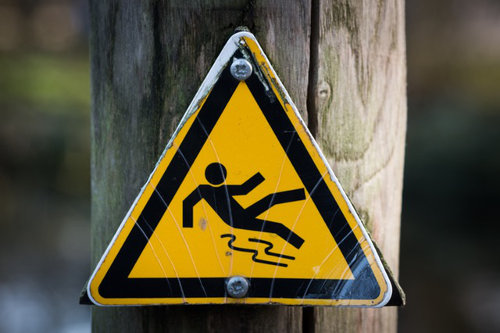Small businesses can be the subject of costly personal injury lawsuits. You’ll want to obtain liability insurance immediately if you have a small business where customers come to a physical location. Premises liability is a doctrine that all business unders are subject to.
The doctrine finds that a business owner can be held liable in a slip and fall accident on the business’s premises.

Business owners have a “duty of care” to make sure the property is safe for employees and customers. You must do everything within reason to make the property safe. Negligence on part of the owner must be shown.
If you’re doing everything in your power, within reason, to make your business a safer place, this is the first step to success. Additional steps should include:
1. Form a Set of Rules and Procedures
If a hazard exists, a set of rules and procedures to follow can help lower your risk of liability. Owners must take quick precautions and correct any hazards as swiftly as possible. Procedures and rules allow you and your staff to:
- Address the problem quickly
- Document the problem
- Seek a resolution to the problem
Sometimes, all that’s needed to fix a hazard is to know which corrective steps to take to remedy the problem.
2. Correct Common Causes for Slips and Falls
Slips and falls lead to a large portion of personal injury cases, and if you want to avoid slips and falls in your business, you must correct the common causes first.
Lighting
A lack of adequate lighting can lead to indoor and outdoor hazards. You’ll be subject to lawsuits if a person:
- Trips on a curb
- Gets robbed or assaulted
- Trips on a product
If visibility is such that the person cannot see and suffers injury due to this lack of visibility, they can seek damages.
Parking Lot Hazards
Parking lots must provide a safe entrance for customers and employees. Hazards in parking lots are numerous and may include:
- Uneven pavement
- Potholes
- Lack of traffic signs
- Lack of signage near construction areas
Parking lots must be safe for all patrons.
Ice, Snow and Sidewalks
Sidewalks often fall under the care of the government, but there are cases wherein a business must provide proper maintenance for sidewalks. If the sidewalk is shared between the city and your business, speak with officials to understand your requirements.
If you’re found to be responsible for maintenance or repairs, you can be sued if the sidewalks are neglected and someone is injured.
There’s also an issue of ice and snow outside of your building. If you’re responsible for the parking lot, walkways or sidewalks, you must:
- Clear snow promptly
- Remove ice
- Remove snow at regular intervals
Proper measures to remove snow and ice, even from the roof of the building, can help keep you safe from premises liability.
You’ll also want to ensure that there are no physical obstacles in the way, such as cords or rugs, that a person can easily trip on.
3. Utilize Proper Signage and Safety Measures
Safety is paramount in any business, and you must take all of the appropriate safety measures to keep customers, patrons, visitors and workers safe at all times. Those signs in front of recently cleaned bathrooms or floors are there for a reason – liability protection.
You must supply and implement proper signage that warns of potential safety risks and hazards.
You must also:
- Maintain all flooring
- Eliminate hazardous conditions promptly
- Repair uneven surfaces
- Train employees on proper safety measures
- Incorporate fall safety measures and incident reports
- Maintain updated maintenance records
- Obtain and maintain premises liability insurance
If you follow these three steps, you’ll lower your risk of premises liability lawsuits. But you also want to maintain the proper insurance so that if an incident does occur, you have insurance to negate the costs.


